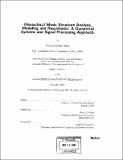Hierarchical music structure analysis, modeling and resynthesis : a dynamical systems and signal processing approach
Author(s)
Adán, Víctor Gabriel
DownloadFull printable version (7.448Mb)
Other Contributors
Massachusetts Institute of Technology. Dept. of Architecture. Program In Media Arts and Sciences
Advisor
Barry L. Vercoe.
Terms of use
Metadata
Show full item recordAbstract
The problem of creating generative music systems has been approached in different ways, each guided by different goals, aesthetics, beliefs and biases. These generative systems can be divided into two categories: the first is an ad hoc definition of the generative algorithms, the second is based on the idea of modeling and generalizing from preexistent music for the subsequent generation of new pieces. Most inductive models developed in the past have been probabilistic, while the majority of the deductive approaches have been rule based, some of them with very strong assumptions about music. In addition, almost all models have been discrete, most probably influenced by the discontinuous nature of traditional music notation. We approach the problem of inductive modeling of high level musical structures from a dynamical systems and signal processing perspective, focusing on motion per se independently of particular musical systems or styles. The point of departure is the construction of a state space that represents geometrically the motion characteristics of music. We address ways in which this state space can be modeled deterministically, as well as ways in which it can be transformed to generate new musical structures. Thus, in contrast to previous approaches to inductive music structure modeling, our models are continuous and mainly deterministic. (cont.) We also address the problem of extracting a hierarchical representation of music from the state space and how a hierarchical decomposition can become a second source of generalization.
Description
Thesis (S.M.)--Massachusetts Institute of Technology, School of Architecture and Planning, Program in Media Arts and Sciences, 2005. Includes bibliographical references (p. 153-156).
Date issued
2005Department
Program in Media Arts and Sciences (Massachusetts Institute of Technology)Publisher
Massachusetts Institute of Technology
Keywords
Architecture. Program In Media Arts and Sciences